Between the Borg and a Hard Place
My review of the grand strategy game Star Trek: Infinite, which sadly isn't very good.

The idea behind Star Trek: Infinite is a solid one: Take the celebrated grand strategy space opera game Stellaris and make it more accessible to Star Trek fans. That is exactly what the team from small Argentinian developer Nimble Giant Entertainment did. But the way in which they did this largely disappoints.
22/100 • “Don’t Buy” ↓ Jump straight to the 𝔉Λ฿ score
I love Stellaris. I’ve played several hundred hours of the game. And I also love Star Trek, having seen every series that was made before the very ill-advised reboots post-2009 at least five times in its entirety. I continually watch these series to this very day. As such, I felt I was the perfect audience for Star Trek: Infinite — a fervent Trekkie who loves grand strategy games — and did not hesitate to buy the game immediately upon its release.
A Disastrous Release
Maybe that was part of the problem, as Star Trek: Infinite has had an extremely rough launch. To call this game unpolished on launch would be a massive understatement. This release was a mess. Launch day bonus DLC that people had purchased for no small amount of money wasn’t recognised or activated by the game’s launcher. The tutorial wasn’t functional for players on Macs. And many people experienced crashes and game-breaking bugs. I myself ran into several issues with how the game triggers events that prevented me from progressing through missions or the storyline. Nothing of what I experienced broke my safe games permanently, but a lot of it was very annoying.
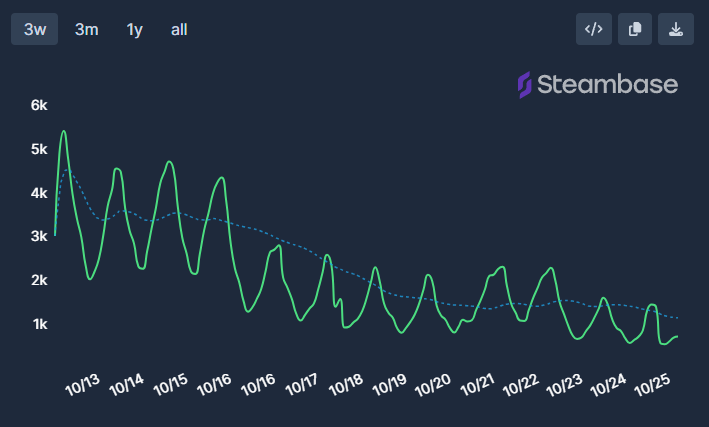
Total player numbers for Star Trek: Infinite – this is not what a successful game launch looks like. (Source: Steambase)
Most of these issues have since been fixed by the developers with several patches that have come out since, but some of the bugs players experienced in the days after launch are simply inexcusable. It seems to me that neither the game’s tutorial, nor the mechanism to activate bonus purchases was tested at all before the launch of the game. The former was clearly broken for all players at launch — and terminally so for Mac users — and the latter needed three different patches before it started working correctly. The whole launch screamed amateur hour to me.
Horrendous Voice Acting, Subpar Music
Leaving these bugs aside and looking at the game as it stands at the time of me writing this review, there are several very bad choices by the developers that immediately grab your attention when you start playing and which soured my mood to the game significantly. The worst problem of Star Trek: Infinite is certainly the voice acting. In the era of Critical Role and voice actors getting more and more recognition in the video game industry — not to mention genius voice acting performances in games like Cyberpunk 2077, Pillars of Eternity and Disco Elysium, to name but a few — it is absolutely inexcusable to deliver something this bad. The voice acting in Star Trek: Infinite sounds like random development studio employees reading lines that were recorded in some broom closet. I’m not even kidding here, it actually sounds that bad.
Not even the for-pay Klingon language DLC was recorded with people who sound anything like Klingon characters in TNG or DS9. The net effect is one of utter disconnectedness with the Star Trek universe. It would have been much more immersive had they simply skipped voice lines altogether, instead of releasing such a shitshow.

At first glance, Star Trek: Infinite seems to deliver what it promises, a version of Stellaris that looks and plays like it is set in the Star Trek universe.
And sadly, the music isn’t much better. It largely sounds like a generic science-fiction soundtrack. Only in one or two songs are there some hints of familiar Star Trek melodies. Come on, guys! Games published by Paradox Interactive usually have stellar soundtracks. And it isn’t that hard to make your own music sound like Star Trek. You just have to throw Alexander Courage’s fanfare in there a few times, for fuck’s sake! Star Trek composers of many diverse backgrounds have been doing this kind of thing for many, many decades now.
Lovely Art Direction
One of the few positive elements in this game, and frankly the only thing that makes this even remotely look and feel like Star Trek, is the game art. It is simply lovely and very faithful to the TNG era of Star Trek. But that alone can’t do all the immersion work. For something like this to click with the player, the art, the sounds, the music and the gameplay all have to come together to make a continuous whole that feels like Star Trek.
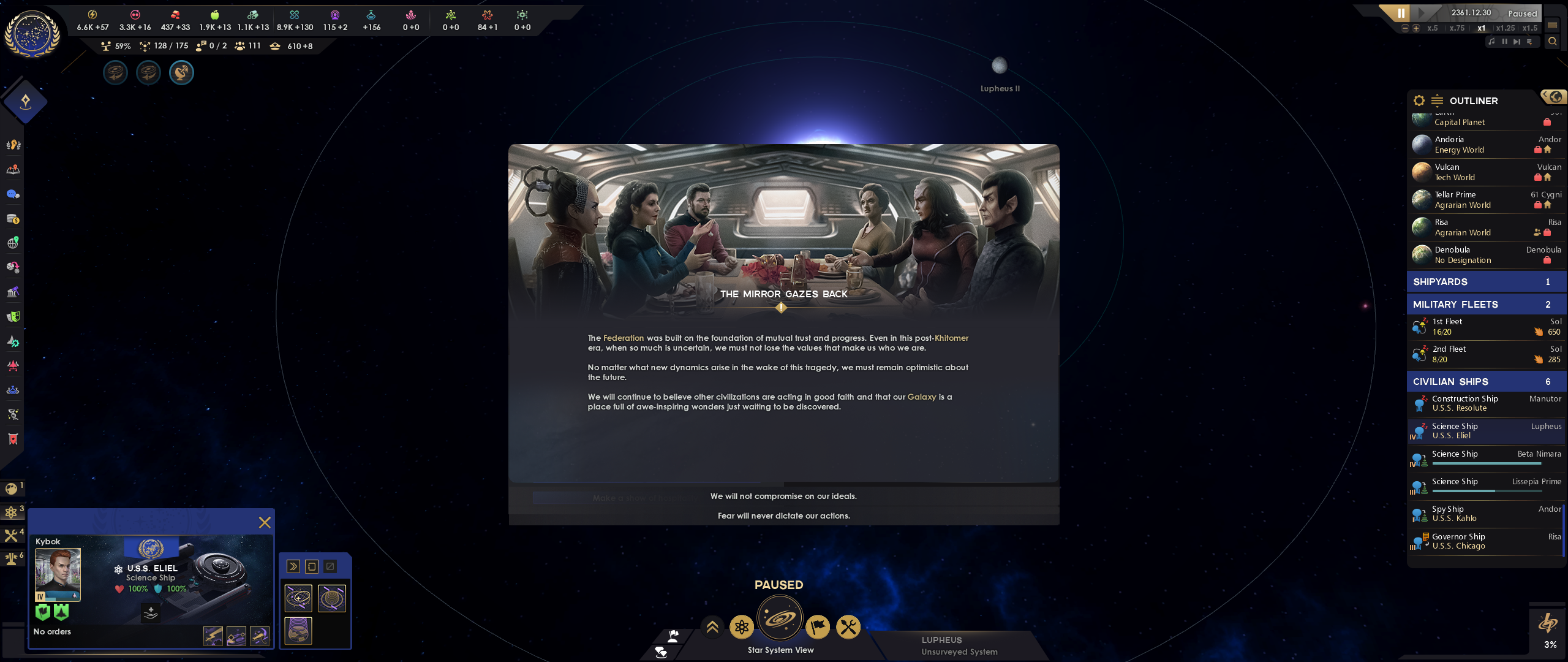
The artwork is what gives this game its Star Trek vibe. They nailed the feeling of the TNG era of Trek. Sadly, that isn't enough to carry the game.
Immersion is the most important aspect of a game like this. Players want to feel like they are part of the universe they can otherwise only experience on the TV and movie screens. Why else would a game like this exist? If you want to simply act out space opera science-fiction stories in a grand strategy sandbox, Stellaris has allowed you to do that for years. If you slap a Star Trek brand on this kind of gameplay, you need to deliver the specific Star Trek feeling that people crave. And good art simply isn’t enough. You also need the matching sounds and gameplay and none of that is there in this case.
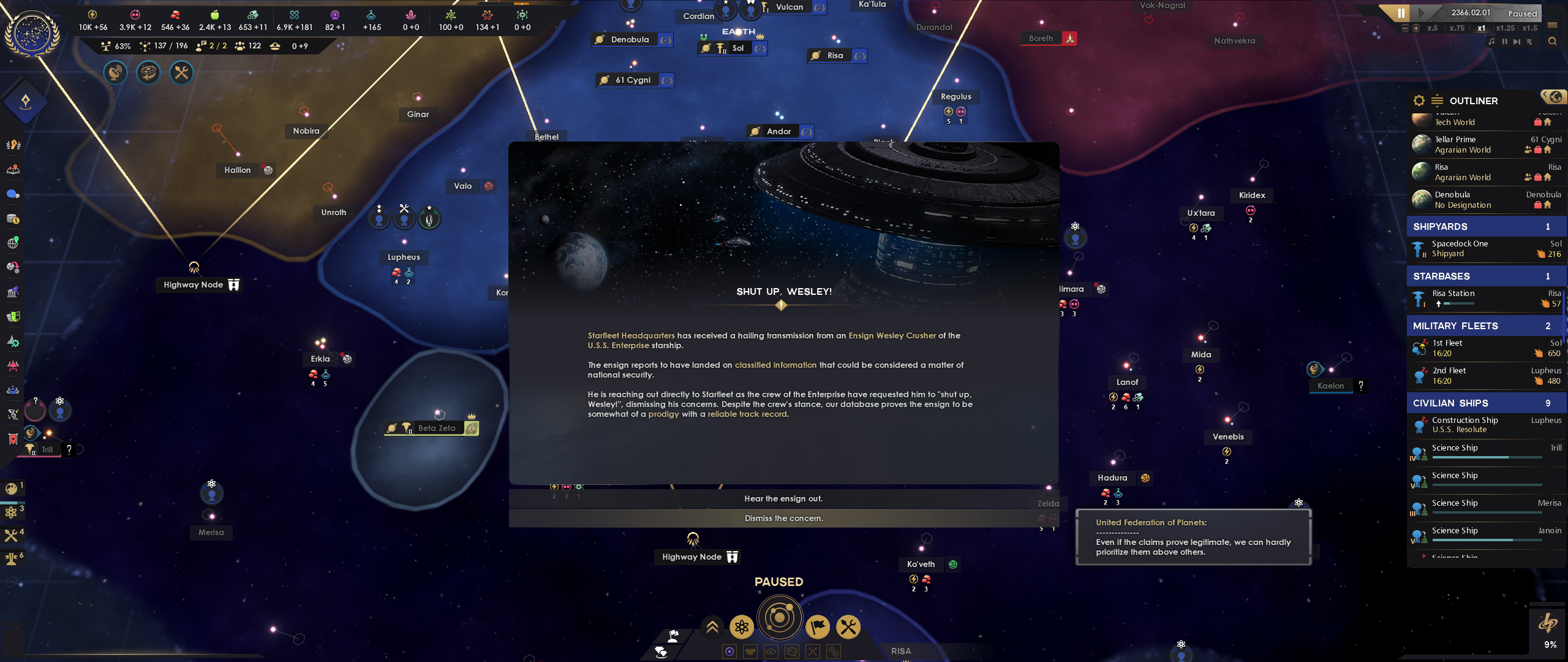
I also give the developers props for little nuggets like this. It seems to me that they know their stuff when it comes to lore and are passionate about Star Trek, they just failed to execute on much of what they probably wanted to do.
From the weapon sounds that simply do not replicate the very specific effects that any TNG, DS9 or Voyager fan knows instinctively and can tell apart with closed eyes, to the look of the weapons on the battlefield …none of it fits. This includes many technologies in the tech tree which are obviously badly adapted from Stellaris and simply don’t exist in Star Trek or have been very half-heartedly camouflaged to at least sound like Trek technologies. Many of these things, and their corresponding gameplay effects, simply make no sense in a Star Trek setting. You can’t simply make this go away by slapping some, admittedly very nice, artwork on it.
The Gameplay
Which brings us to how the game actually plays. On a positive note, the developers did succeeded in making Stellaris, a notoriously complicated epic grand strategy game set in space, much more approachable to new or somewhat casual players. Star Trek: Infinite does not improve on Stellaris in any meaningful way (aside from maybe cleaning up the UX in some places) but that’s okay. That is not its goal. Its goal is to deliver an experience on top of Stellaris that feels uniquely like Star Trek. The problem is that the game also fails in this respect. Playing this game feels more like playing a dumbed-down version of Stellaris than something new or something that specifically makes you feel like you’re in the Star Trek universe.
Instead of redesigning the tech tree and underlying mechanics, the developers simply borrowed wholesale from Stellaris and slapped a coat of Star Trek flavour on it. Sadly, that coat is so thin that it’s fooling absolutely nobody. One of the innovations, a mission tree that lets you build iconic Star Trek staples like the Enterprise-D and Deep Space Nine, is very badly designed. Not only are many of the individual missions not very fitting to what actually played out in the canonical storyline, they are also hard to complete and can be locked off by chance or wrong decisions on your part, leaving you with whole branches of missions you can’t complete.
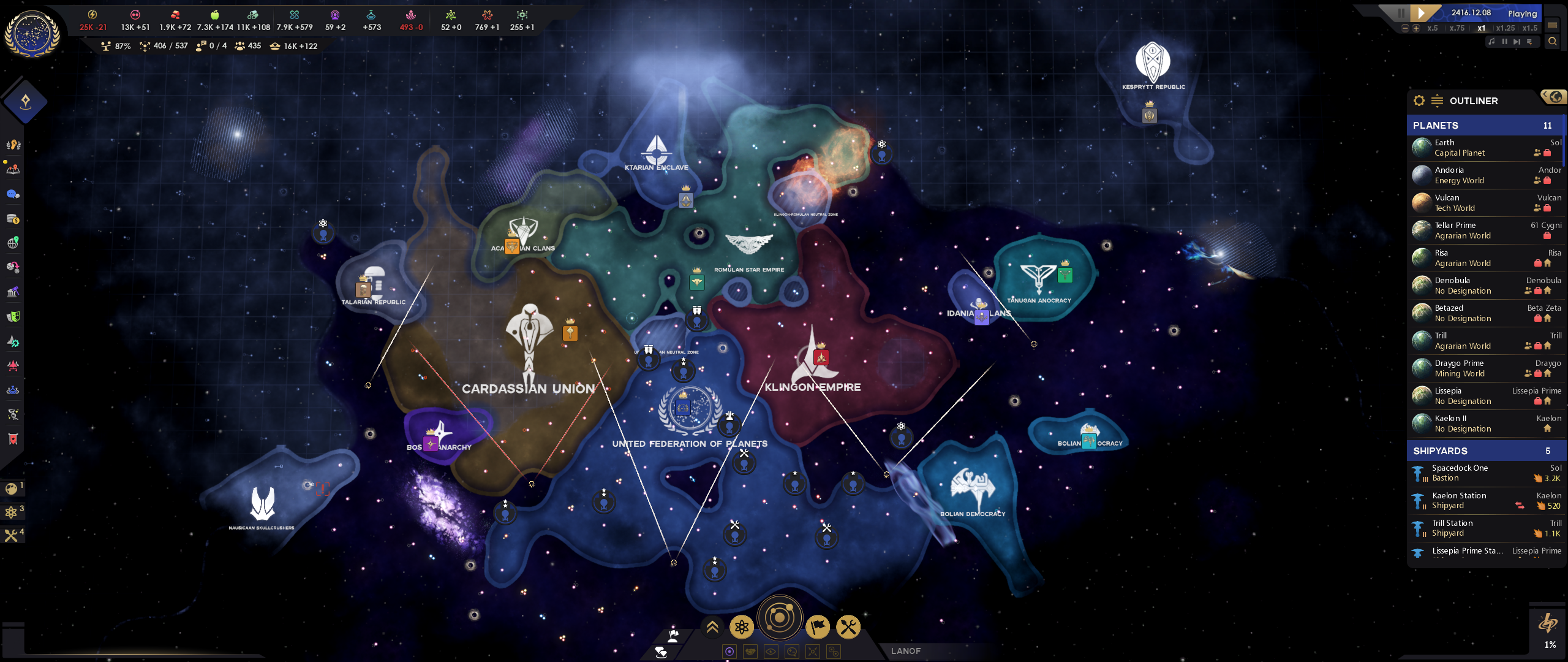
This is what a UFP playthrough looks like in terms of expansion in the middle of the game. The Federation should really be this large, or larger, at the very outset of the game to fit with the story the game is telling.
Playing as the United Federation of Planets, which is recommended for beginners, is rather boring, as the diplomacy gameplay simply isn’t spectacular and all other empires act very friendly most of the time. Unlike they did in the actual canon history of the UFP. The game also starts in the wrong period in history, right after the Khitomer Massacre, which doesn’t at all fit with how big the different empires are (especially the Federation) at the outset of the game. At that time, the UFP was pretty much already established at its maximum size, leaving little excuse to have the player then engage in enlarging the Federation in the game. The only reason you’re doing this is because that’s the standard Stellaris gameplay loop. It doesn’t feel right in terms of the story.

Managing this many star systems is easier than it would be in Stellaris, but I'm still not sure it's much fun.
The big endgame threat, the Borg, are similarly misplaced. Due to the in-universe time of the game start and the way the story unfolded in TNG and Voyager, the Borg simply aren’t scary at all. The Borg are easily dealt with, unless an unlucky decision or a bug prevents you from building the Enterprise-D, and frankly, they are anticlimactic. All of this conspires to make me think this kind of gameplay just wasn’t a good fit for the kind of Star Trek story the developers tried to tell.
This is Probably an Unrecoverable Wreck
Star Trek: Infinite is stuck between trying to tell a linear Star Trek story and giving players the freedom they expect from a grand strategy game. It never finds a satisfying solution to either the one or the other, or, as I think was the idea, to mate both concepts into a unified whole. Part of this is clearly the game design, but that the rest of the game can’t deliver the kind of immersion its gameplay loop desperately depends on, doesn’t help matters.
This game feels like something a dedicated Stellaris modding team could have done a better job of. Especially if that team would’ve had an actual Star Trek license. As it stands, the game’s botched released can’t be saved by the hypothetical solid gaming experience that could be coaxed out of its shell with enough patches. I feel like that experience simply doesn’t exist. Sure, the developers could record all-new voice acting performances, a new soundtrack that actually sounds like Star Trek and replace all the effects with ones that actually look and sound like Star Trek technology, but one has to assume that this is a bit of a long stretch. Especially since all of this could have been done in the first place. Most of the gameplay could be fixed, and given Paradox’ history it might well be, but without a thorough reworking of the aforementioned factors, this game will never really feel like a convincing Star Trek.
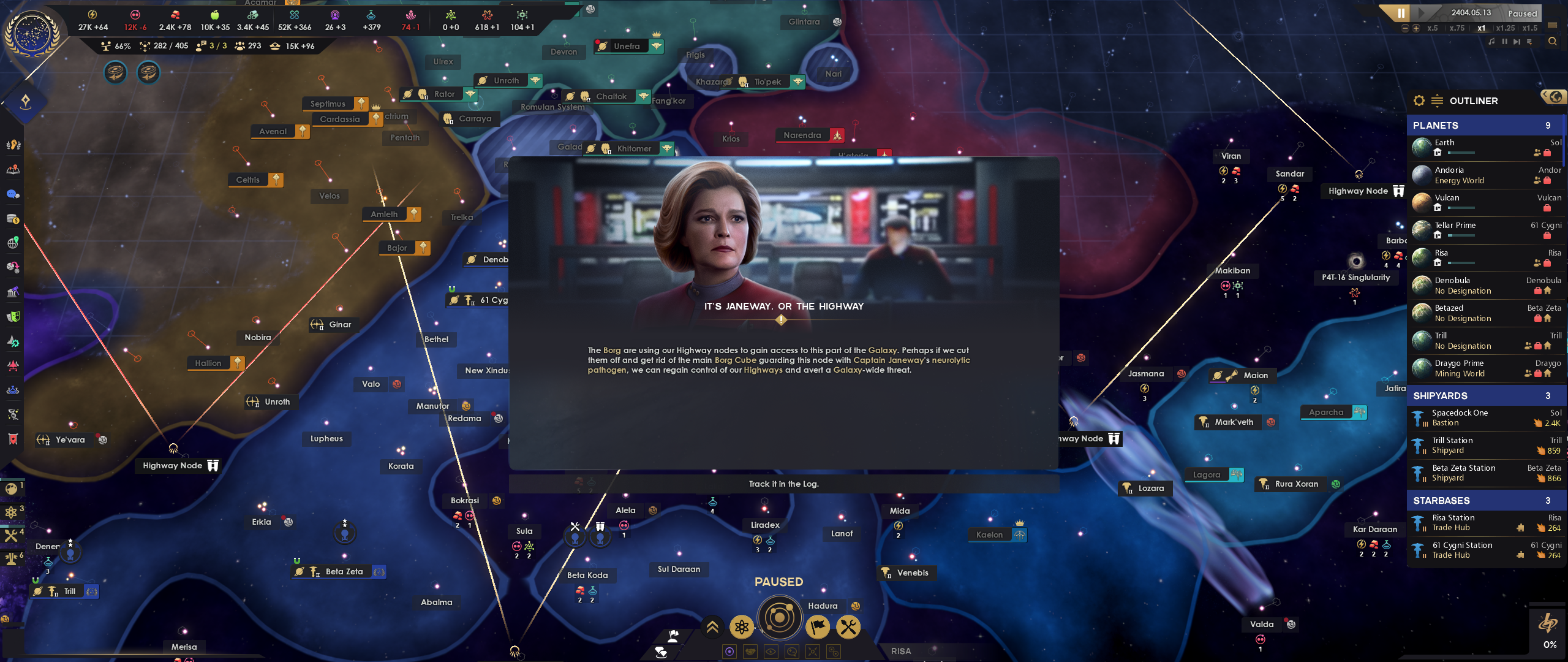
THERE ARE TOO MANY BAD PUNS! Also: WTF!?! Why not name these things transwarp conduits? Space highways just aren't very Trek...
Which is a shame, because one can easily see a parallel universe where this idea was executed well and this game had a successful release that made many Trekkies and even Stellaris players happy. That just didn’t happen in our Prime Reality. Sadly, it seems that the era where I could pre-order any Paradox game sight unseen and knew I would at least enjoy it for 50 to 60 hours is now over. After the disaster that was The Lamplighters League followed by this release and now the performance mess that is Cities Skylines II, I feel that Paradox has lost its way and needs to badly reconsider recent management decisions.
𝔉Λ฿ Score • Star Trek: Infinite • 22/100
This could have been such a great game. Sadly, it appeals neither to the die-hard Star Trek fan, nor the grand strategy enthusiast. I don’t know who would actually enjoy this — just stay away from it.
Star Trek: Infinite is too linear to be a decent grand strategy game and it’s not linear enough to let you experience what you’ve seen on TV in a satisfying manner. The game isn’t an improvement on any particular aspect of Stellaris, nor does it offer anything that Stellaris doesn’t have; aside from branding and visuals. You can have some fun while playing Star Trek: Infinite, but only in a very limited way.
𝔉un 15/50
The game art looks nice, but that’s about it. The music, the voice acting and most of the effects for the ships and space phenomena are pretty bad and have little in common with Star Trek. Had they released just the game art as an add-on for Stellaris, even at the same price, it probably would’ve been a better idea.
Λrtistry 5/25
There is nothing new or original here. Which in itself wouldn’t be so bad, if this was just a well executed reskin of Stellaris that’s faithful to the TNG era of Star Trek. The problem is that the game utterly fails in this respect as well. And let’s not even start talking about what this game concept could have become in the hands of people with actual artistic vision and talent.
฿oldness 2/25
Total Score: 22/100 • Don’t Buy
